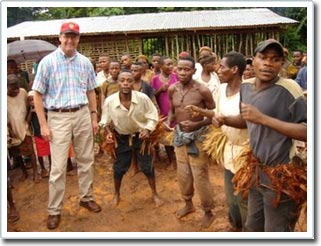Why Pygmy people dwarf?
Scientists still debate the reason why Pygmy people are small and called ' dwarfs '. Previously, scientists thought that Pygmy's small stature was aimed at reducing calories and making it easier for them to move in the jungle. However, recent research by Cambridge University researchers shows that the interpretation is not satisfactory and gives another assumption. Pygmy people have an average height of men of less than 155 cm. With this characteristic, Pygmy people are present in many parts of the world: Africa, Malaysia, Thailand, Brazil and Bolivia. The diverse living environment shows that the small size of learning is not entirely due to the environment in the traditional interpretation.
Besides, there are other types of people with the same living conditions as Pygmy people but they do not have such small stature. For example, there are communities that live in the jungle and often face food scarcity, which still has a large stature.
Now scientists Andrea Migliano, Lucio Vinicius, and Marta Lahr conduct research on two Pygmy groups named Aeta and Batak in the Philippines that they have found the cause of this small stature. Their research results are published in the National Science Council Meeting Minutes
Scientists have shown a rare feature in ordinary people but it is common in Pygmy people that Pygmy people have a relatively short life expectancy compared to other groups . On this finding, the team believes that the small size of Pygmy people is a side effect from their survival strategy.

Pygmy dwarfs are dancing with US Ambassador R. Niels Marquardt in Lobeke International Park, Cameroon in 2006 (Photo: Federal Government.)
Migliano answered PhysOrg.com's interview: 'At first we thought there was a connection between small stature and the health of Pygmy people. For example, the lower the person, the more advantageous the taller, the higher the fertility, for example. But even lower people are less fertile than tall people. Therefore, we think the possibility of small stature is not really a favorable thing for Pygmy people. '
'Then, when I went directly to and interviewed them, I noticed that the mortality rate was especially high compared to other groups. So we checked and found that the Pygmy group in other places also happened the same case. Moreover, life is one of the methods to learn about the diversity of mammalian stature, so we believe that this should also be applied to understanding human diversity. '
It is because of the shorter life that scientists think their reproductive age is also pushed up earlier.Their average life expectancy at birth is only between 16 and 24 years old, a common figure for Pygmy groups . There are very few Pygmy women who live to the end of their childbearing age and very few people live past the age of 40.
To compensate for the shortage of women of childbearing age, Creator pushed their reproductive age earlier. The most appropriate reproductive age in the Aeta group is 15 years old, making up for their short lifespan and saving time for the generation of future generations.
Pygmy people to age reproduce faster than others strains live longer than them. For this reason, many Pygmy people stopped growing at the age of 12 a few years earlier than the average person. But Pygmy children have the same growth as children of other strains and they have the same stature. This case is in contrast to the malnutrition cases in which people temporarily stop developing and then reach adult size later. Instead of strong growth in puberty, the development of Pygmy people is limited.
Migliano explains why Pygmy people do not grow strongly in the early years to compensate for developmental delays at an early age.' I think that besides the high death rate, they absorb very little energy. Combining both of these factors makes their appearance unusual . Pygmy people have the same growth rate and poor diet as the Turkana in East Africa. But because Turkana have a longer lifespan, their bodies have time to grow and they have a larger stature. I believe that a community has a high mortality rate and a rich source of nutrition will grow faster and higher. ' In other words, human height is somewhat affected by their age.
However, the assumption of longevity still has many loopholes. First thing, what caused the high death rate in Pygmy people? Scientists suspect traditional assumptions about the environment, nutrition, heat regulation and other conditions that play a part or all of the high mortality rates in Pygmy groups. In this case, the previous interpretation may be the indirect cause of the small stature of the Pygmy people although the result is much more complicated than the explanation.
- The world really exists dwarf race like hobbits in Africa
- Pygmy: Where an 8-year-old girl became a woman
- Rare dwarf elephants die in mass
- Video: A dwarf was discovered and fled in the Indonesian forest
- The new discovery of Ceres dwarf planet is shocking
- The world's most exclusive dwarf horse
- Strange of the world's smallest animals
- The smallest monkeys in the world
- Unusual red dwarf system detected
- Makhunik - controversial village about the presence of
- Discover the land used to have bizarre creatures living
- Revealing a new dwarf planet right in the Solar System
 'Fine laughs' - Scary and painful torture in ancient times
'Fine laughs' - Scary and painful torture in ancient times The sequence of numbers 142857 of the Egyptian pyramids is known as the strangest number in the world - Why?
The sequence of numbers 142857 of the Egyptian pyramids is known as the strangest number in the world - Why? History of the iron
History of the iron What is alum?
What is alum?